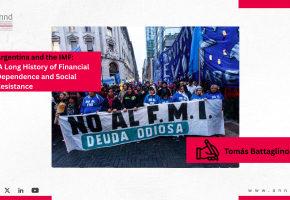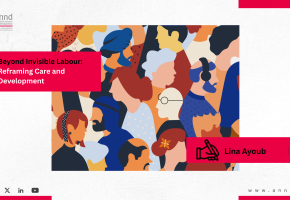
Where is the women, peace and security agenda heading in the region? - Manar Zaiter

Where is the women, peace and security agenda heading in the region? - Manar Zaiter
In October 2000, UN Security Council Resolution 1325 paved the way for developing what is now known as the Women, Peace and Security Agenda.
For over two decades, the Agenda was a success internationally and nationally. Resolution 1325 and subsequent resolutions brought about a significant change in the global discourse. They renewed the discussion about the various roles played by men and women during and after conflicts. While the premise of recognizing gender equality previously recognized women as victims, they are now recognized as active agents for peace and security. The significance of these resolutions is in their binding nature, based on Article 24 of the UN Charter. Moreover, Resolution 1325 was the first international recognition of the importance of women in the discourse of peace and security and the first political and operational tool that changed the security concept and reshaped the issue of women’s rights in the context of conflicts and their aftermath.
Despite the importance of this international agenda, and despite the evidence supporting its transformative power, the wars and crises that the Arab region has been experiencing for years, and the flagrant violation of all human rights that Palestine is experiencing today, require the feminist movement in the Arab region to think deeply and consider a different approach to the agenda. An approach based on adherence to the international women’s rights system as a system of values and standards that must constitute a guiding and binding framework, in parallel with the start of regional discussion and reflection on this system with the aim of developing it and restoring its effectiveness, in light of the many gaps that afflict it and limit its effectiveness.
Resolution 1325 acknowledges women’s participation in peacebuilding and conflict resolution, but it silences feminist critiques of structural militarism and fails to acknowledge the complex connections between peace and gender equality. It does not condemn conflict itself, but rather certain aspects of it. It leaves out the structures and systems of war. A focus on reconstructing masculinities and femininities as a strategy for resisting militarism is essential to returning the agenda to what could be seen as its “original” purpose of preventing war. This approach helps reaffirm the limits of women, peace and security policies as a political agenda and a means to achieving a feminist anti-militarism goal. The liberal vision of women, peace and security has been dominated by a focus on adding women to military structures rather than changing how international security is understood and pursued, and on “making war safe for women” rather than preventing it. Thus, the idea of women’s advancement in highly militarized contexts contradicts the feminist anti-militarization critique that began when women peace advocates from around the world gathered at the International Conference on Women in The Hague on 28 April 1915. In this sense, the institutional context of the agenda can be questioned, as it appears as if it is not trying to prevent wars or question their legitimacy, but rather seeking to make wars a safer space for women and protect them in these contexts. In parallel, some implicit stereotypes in Resolution 1325 are evident, namely the assumption that increasing the inclusion of women will lead to a shift in how they are treated in war zones. This confirms gender stereotypes that place women as peacemakers. Hence, the importance of the feminist movement in our region formulating its position on wars and the killing machine that is tearing our countries apart, from national political perspectives. A position that rejects wars and conflicts as tools for consolidating regimes and suppressing peoples’ right to self-determination and expressing their choices. A position that has a clear understanding of the course of conflict in the region.
Second, resolution 1325 fails to address the structural causes of inequality that make women the most victims in war zones. Women are included in peace and security measures as a separate issue from gender inequality. Addressing women and girls’ strategic interests is more than necessary, but it requires a broader approach to structural inequality, which is exacerbated in wars and prevents women from accessing basic rights. In this sense, the resolution refers explicitly to women, leaving aside existing power structures that take on more acute forms during conflicts, and does not address the structural causes that exclude women and do not help protect them. It therefore does not address structural issues, such as poverty or culture, as crucial components of the approach to women’s issues. This approach has paved the way for the depoliticization of the agenda, as the women, peace and security agenda has been treated as separate from broader emancipatory projects, making it merely a tool for the patriarchal reproduction of gender relations, rather than a emancipatory and political tool.
Thirdly, Resolution 1325 lacks enforcement mechanisms that contribute to its effectiveness. The limitations imposed on international resolutions and the lack of explicit enforcement mechanisms make them function only as a set of guidelines. The resolution does not provide any references to accountability or implementation mechanisms for its progress or any criteria or targets to measure that progress. Therefore, there is strong talk in the halls of the UN about strengthening areas of synergy at the substantive and procedural levels between the resolution and the rest of the women's rights mandates. The biggest problems now are the ability of the various UN bodies and mechanisms to achieve peace and the loss of public confidence in them.
The fourth gap concerns the localization of the agenda. More than two decades of the agenda’s history have revealed how its organizational framework is not adapted to local contexts, reflecting the features of the context from which it emerged, namely the UN Security Council. Here, we can talk about the inclusion of colonial concepts in the agenda. National action plans of countries of the Global South are not necessarily local in their entirety, due to the influence of organizations from the Global North or international organizations in their development process, which turns the WPS agenda into an action plan to perpetuate the hegemony of the North over the South. Most of the localization approaches that have been promoted have not been successful. An example of this is the hierarchies of knowledge produced by institutions located within the “secure” Global North, which attempt to frame work in the “insecure” Global South. This is directly linked to the power dynamics between the North and the South. This calls for thinking about the feminist movement’s relevance to its own context, rather than replicating the discourse and agenda of international organizations and agencies. Unfortunately, the stereotypes of the East, created by colonialism, are reflected in the methods of work of many international interventions and in their programs that are returned to the organizations of the Arab region to be consecrated, and whose features change decade after decade in connection with the development of Western visions without exploring whether these visions can be adopted and applied in the Arab world. In the past decades, in light of the meager or non-existent local funding in Arab countries and the reliance of women’s organizations on external funding institutions, women’s work against hegemony, patriarchy and capitalism has declined, and most local organizations – not all of them – adopt this pattern and willingly reproduce these visions and reflect them in their relations with local communities, most of which still have reservations about these discourses, whether through ignorance, direct criticism or adherence to values that distinguish between the sexes.
Finally, the agenda contributed in one way or another to the consecration of “state feminism,” with non-democratic regimes taking over the women’s rights project and the initiative of national mechanisms concerned with women’s affairs to develop “national plans for resolution 1325.” Despite the importance of these plans, they tamed in one way or another the feminist discourse on women, peace and security issues. This contributed, in the strategic term, to emptying the work in the region on the agenda and those behind it of the work on various feminist issues of the required political dimension.
In conclusion, there is much to consider and research between seeing the WPS Agenda as an indispensable tool in the field of peace and security and reading it as part of the current neoliberal global political and economic system. The feminist movement in the Arab region has a lot of work to do, with the aim of adapting the agenda within a transformative feminist political project.
There are undoubtedly challenges ahead. How can we, for example, work within international agendas for women’s rights in light of the international inability to hold Israel accountable for all its crimes? How can we trust again the many feminists working on peace and security issues in the world in light of their positions on what is happening in Palestine? How can we trust the foreign policy of some donor agencies that talk about liberating Palestinian women from “violence and discrimination” without talking about their right to a land on which to live? In 2024, the dark cycle of history is repeating itself. Large segments of liberal Western feminism are adopting positions that do not condemn the crime of genocide to which the Palestinian people are being subjected. While this is reminiscent of Western feminist positions on women’s crises in Iraq, Afghanistan, Libya, Syria, Yemen, and elsewhere, the link between it and the feminist narrative that says “women in this region need liberation and rescue from male oppression and from extremist religious forces” seems clear, which ignores the structural causes of women’s reality. Thus, the plight of Palestinian women, for example, is reduced to the violence of the “Palestinian man,” “Arab patriarchy,” or “religious fundamentalism,” while the occupation and the absence of peace and security are ignored. It is as if we are dealing with feminist positions based on double standards and a desire to prevent women in the South from dealing with and interacting with their identities, existence, and rights to participate in determining the fate of their countries.
Recent publications

